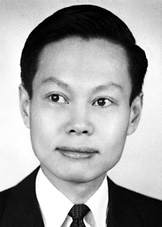Chen-Ning Yang
Created and Claimed by ryanbaker2754 (Ryan Baker). PHYS 2211.
Chen-Ning Yang, born on October 1, 1922 in Hofei, Anwhei, China, is a Chinese-born American who works toward the further development of particle physics as well as statistical mechanics. He is most known for his work on the Lee-Yang Theorem of quantum-mechanics for which he received a Nobel Prize (1957).

Early Years and Career
Yang's father, Wu-Chih Yang, was a mathematician, and his mother, Mong-hwa Lo, was a homemaker. Yang attended elementary school and high school in Beijing until the Japanese invasion of China in 1938 when they moved to Kunming, Yunnan. In his sophomore year in high school, Yang passed the entrance exam at the National Southwestern Associated University and proceeded to further his studies there. In 1942, he received his Bachelor's degree with his thesis on the application of group theory to molecular spectra, under his mentor Ta-You Wu. He then went on to receive his Master's in 1944 from Tsinghua University where he worked on statistical mechanics. Yang ended up receiving a scholarship set up by the United States government using part of the money China had been forced to pay following the Boxer Rebellion. From 1946 to 1948, Yang studied at the University of Chicago where he earned his Doctorate in Physics. In 1949 he went on to do research at the Institute for Advanced Study in Princeton, New Jersey, where he continued his work in statistical mechanics and began collaboration with Tsung-Dao Lee with whom he won a Nobel Prize (1957). He began his work as a professor at the University in 1955. In 1963, Princeton University Press published his textbook, Elementary Particles. In 1965 he moved to Stony Brook University; there he was named the Albert Einstein Professor of Physics. The institute is now know as "C. N. Yang Institute for Theoretical Physics". In 1999 he retired from Stony Brook University. After retiring from Stony Brook he returned as an honorary director of Tsinghua University in Bejing. He now is a Distinguished Professor-at-Large at the University of Hong Kong where he has a place on the Board of Adjudicators for the Shaw Prize.
Lee-Yang Theorem
In its simplest form, the Lee-Yang Theorem states that "all zeros of the partition function of the Ising model with free or periodic boundary condition lie on the unit circle in the complex plane where the complex parameter is the exponential of an external field." Chen-Ning Yang and his partner Tsung-Dao Lee also recognized the significance of these zeros for the understanding of phase transitions. They stated that "non-analyticity of physical quantities will develop only when the set of the zeros pinches the physical domain of the relevant parameter space." In 1973, Simon & Griffiths extended the Lee–Yang theorem to certain continuous probability distributions by approximating them by a superposition of Ising models. The theorem has since been expanded upon and applied by physicists such as Newman (1974) and Lieb & Sokal (1981). Some physicists, such as Newman, have speculated that there is a relationship present between the Lee–Yang theorem and the Riemann hypothesis about the Riemann zeta function.

Notable Awards
Throughout his career as both a physicist and a professor Chen-Ning Yang has received many awards. Most notably, he received the Nobel Prize in Physics in 1957 for his work and development of the Lee-Yang Theorem in conjunction with physicist Tsung-Dao Lee. As a professor, in 1957, Yang earned the Albert Einstein Commemorative Award. Yang later went on to receive the Rumford Prize in 1980, the National Medal of Science in 1986, Oskar Klein Memorial Lecture and Medal in 1988, the Benjamin Franklin Medal for Distinguished Achievement in the Sciences of the American Philosophical Society in 1993, the Bower Award in 1994, the Albert Einstein Medal in 1995, the Lars Onsager Prize in 1999, and finally the King Faisal International Prize in 2001.
References
https://en.wikipedia.org/wiki/Chen-Ning_Yang
https://en.wikipedia.org/wiki/Yang-Baxter_equation
http://www.nobelprize.org/nobel_prizes/physics/laureates/1957/yang-bio.html
http://www.math.ucla.edu/~biskup/Summary/PFzeros.html
Further sources
Chuck Newman explains “Riemann Hypothesis and Statistical Mechanics” using Lee-Yang Theorem